
How to Use ESP32 Devkit V1: Examples, Pinouts, and Specs
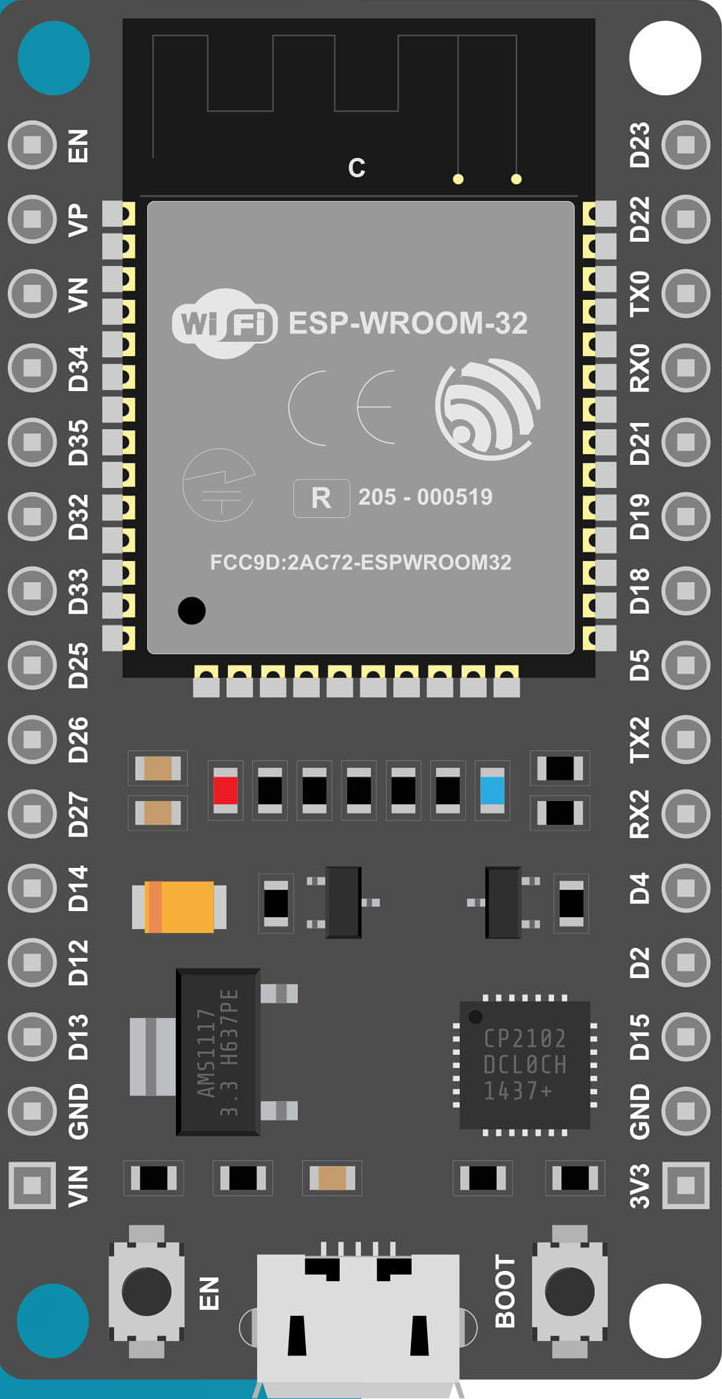
 Design with ESP32 Devkit V1 in Cirkit Designer
Design with ESP32 Devkit V1 in Cirkit DesignerIntroduction
The ESP32 Devkit V1 is a versatile microcontroller development board based on the powerful ESP32 chip. It features built-in Wi-Fi and Bluetooth capabilities, making it an excellent choice for Internet of Things (IoT) applications, wireless communication projects, and rapid prototyping. The board is compact, cost-effective, and widely supported by various development environments, including the Arduino IDE and ESP-IDF.
Explore Projects Built with ESP32 Devkit V1
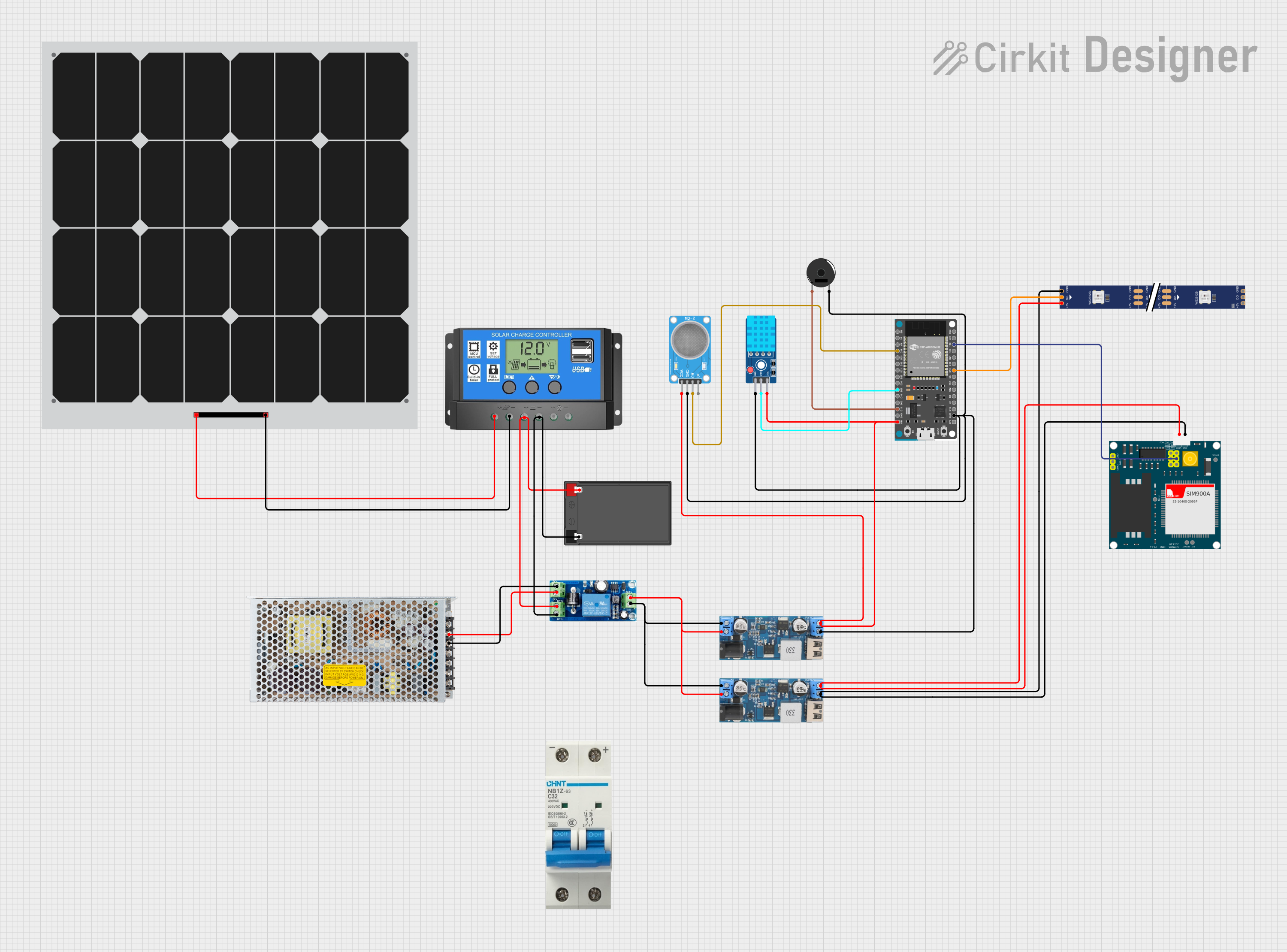
 Open Project in Cirkit Designer
Open Project in Cirkit Designer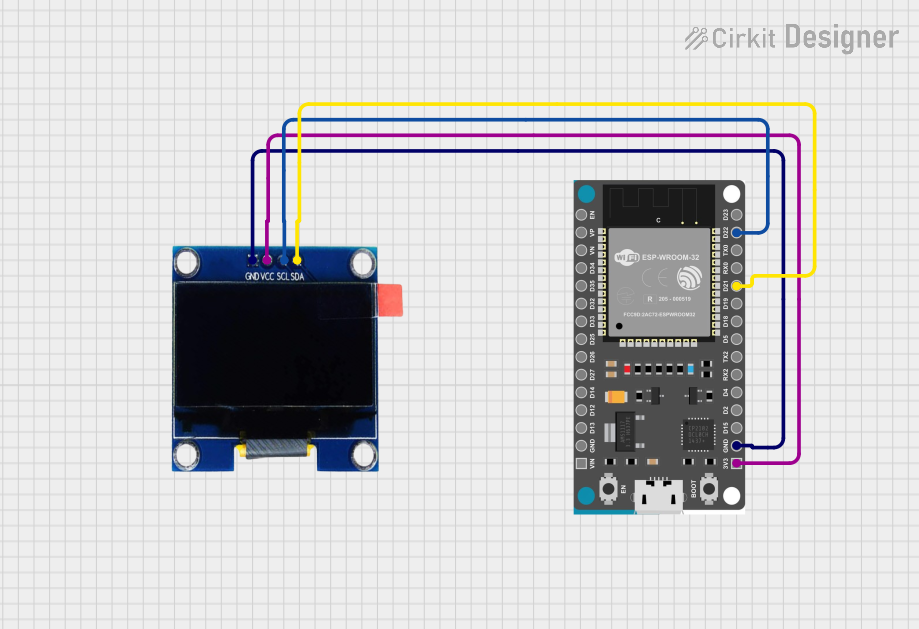
 Open Project in Cirkit Designer
Open Project in Cirkit Designer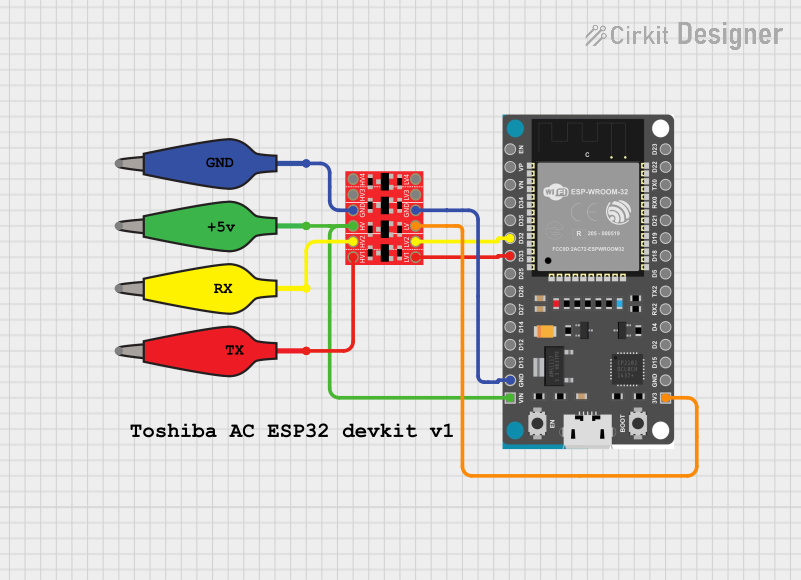
 Open Project in Cirkit Designer
Open Project in Cirkit Designer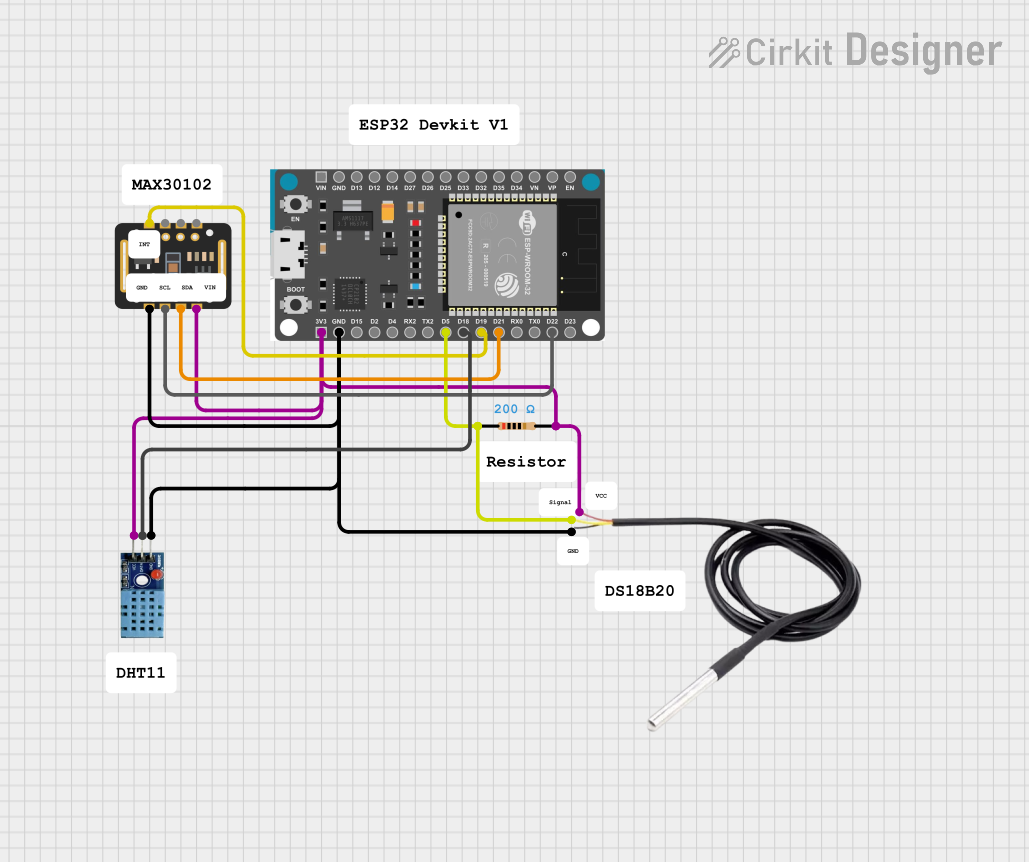
 Open Project in Cirkit Designer
Open Project in Cirkit DesignerExplore Projects Built with ESP32 Devkit V1

 Open Project in Cirkit Designer
Open Project in Cirkit Designer
 Open Project in Cirkit Designer
Open Project in Cirkit Designer
 Open Project in Cirkit Designer
Open Project in Cirkit Designer
 Open Project in Cirkit Designer
Open Project in Cirkit DesignerCommon Applications and Use Cases
- IoT devices and smart home automation
- Wireless sensor networks
- Wearable technology
- Robotics and automation
- Data logging and remote monitoring
- Prototyping for Wi-Fi and Bluetooth-enabled devices
Technical Specifications
The ESP32 Devkit V1 is equipped with robust hardware and connectivity features. Below are its key technical details:
Key Technical Details
- Microcontroller: ESP32 dual-core processor with Xtensa LX6 architecture
- Clock Speed: Up to 240 MHz
- Flash Memory: 4 MB (varies by model)
- SRAM: 520 KB
- Wi-Fi: 802.11 b/g/n
- Bluetooth: v4.2 BR/EDR and BLE
- Operating Voltage: 3.3V
- Input Voltage: 5V (via USB) or 7-12V (via VIN pin)
- GPIO Pins: 30 (varies slightly by manufacturer)
- ADC Channels: Up to 18 (12-bit resolution)
- DAC Channels: 2 (8-bit resolution)
- PWM Channels: Multiple (configurable)
- Communication Protocols: UART, SPI, I2C, I2S, CAN, and more
- Power Consumption: Ultra-low power modes available
- Dimensions: Approximately 54 mm x 27 mm
Pin Configuration and Descriptions
The ESP32 Devkit V1 has a 30-pin layout. Below is a table describing the key pins:
| Pin | Name | Description |
|---|---|---|
| 1 | 3V3 | 3.3V power output |
| 2 | GND | Ground |
| 3 | VIN | Input voltage (7-12V) |
| 4-11 | GPIO0-GPIO39 | General-purpose input/output pins (configurable for ADC, PWM, I2C, etc.) |
| 12 | EN | Enable pin (active high, used to reset the chip) |
| 13 | TX0 | UART0 transmit pin |
| 14 | RX0 | UART0 receive pin |
| 15 | ADC1_CH0-CH7 | Analog-to-digital converter channels (12-bit resolution) |
| 16 | DAC1, DAC2 | Digital-to-analog converter channels (8-bit resolution) |
| 17 | SCL, SDA | I2C clock and data pins |
| 18 | SPI Pins | SPI communication pins (MOSI, MISO, SCK, CS) |
| 19 | BOOT | Boot mode selection (used for flashing firmware) |
Note: Pin assignments may vary slightly depending on the manufacturer. Always refer to the specific datasheet for your board.
Usage Instructions
How to Use the ESP32 Devkit V1 in a Circuit
Powering the Board:
- Connect the board to your computer via a micro-USB cable for power and programming.
- Alternatively, supply 7-12V to the VIN pin or 3.3V to the 3V3 pin.
Programming the Board:
- Install the Arduino IDE or ESP-IDF on your computer.
- Add the ESP32 board support package to the Arduino IDE via the Board Manager.
- Select "ESP32 Devkit V1" as the target board and the correct COM port.
- Write your code and upload it to the board.
Connecting Peripherals:
- Use the GPIO pins to connect sensors, actuators, or other peripherals.
- Configure the pins in your code for input, output, or communication protocols (e.g., I2C, SPI).
Wi-Fi and Bluetooth Setup:
- Use the built-in libraries (e.g.,
WiFi.handBluetoothSerial.h) to enable wireless communication.
- Use the built-in libraries (e.g.,
Important Considerations and Best Practices
- Voltage Levels: The GPIO pins operate at 3.3V. Avoid applying 5V directly to the pins to prevent damage.
- Power Supply: Ensure a stable power supply, especially when using Wi-Fi or Bluetooth, as these features can draw significant current.
- Boot Mode: If the board does not enter programming mode, press and hold the BOOT button while uploading code.
- Pin Conflicts: Some pins are reserved for specific functions (e.g., GPIO0 for boot mode). Check the datasheet before using them.
Example Code: Blinking an LED
Below is an example of how to blink an LED connected to GPIO2 using the Arduino IDE:
// Define the GPIO pin where the LED is connected
const int ledPin = 2;
void setup() {
// Set the LED pin as an output
pinMode(ledPin, OUTPUT);
}
void loop() {
// Turn the LED on
digitalWrite(ledPin, HIGH);
delay(1000); // Wait for 1 second
// Turn the LED off
digitalWrite(ledPin, LOW);
delay(1000); // Wait for 1 second
}
Troubleshooting and FAQs
Common Issues and Solutions
The board is not detected by the computer:
- Ensure the USB cable is functional and supports data transfer.
- Install the correct USB-to-serial driver (e.g., CP2102 or CH340, depending on your board).
Code upload fails:
- Check that the correct board and COM port are selected in the Arduino IDE.
- Press and hold the BOOT button while uploading the code.
Wi-Fi connection issues:
- Verify the SSID and password in your code.
- Ensure the router is within range and supports 2.4 GHz Wi-Fi (ESP32 does not support 5 GHz).
GPIO pin not working as expected:
- Confirm the pin is not reserved for special functions.
- Check for wiring issues or incorrect pinMode configuration in the code.
FAQs
Q: Can I power the ESP32 Devkit V1 with a battery?
A: Yes, you can use a LiPo battery or any other 3.7V-4.2V battery connected to the VIN or 3V3 pin. Ensure proper voltage regulation.
Q: How do I reset the board?
A: Press the EN (enable) button to reset the board.
Q: Can I use the ESP32 Devkit V1 with MicroPython?
A: Yes, the ESP32 supports MicroPython. Flash the MicroPython firmware to the board and use a compatible IDE like Thonny.
Q: What is the maximum number of devices I can connect via Bluetooth?
A: The ESP32 supports up to 7 devices in Bluetooth Classic mode. For BLE, the number depends on the configuration and available memory.
By following this documentation, you can effectively use the ESP32 Devkit V1 for a wide range of projects and applications.